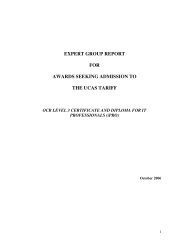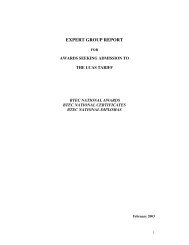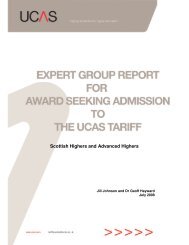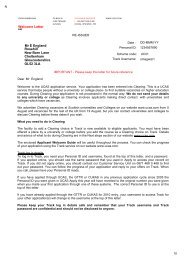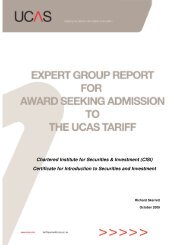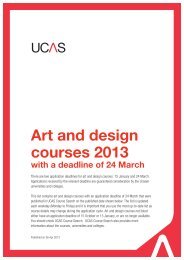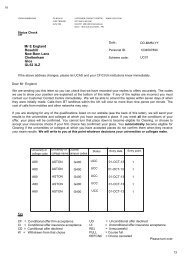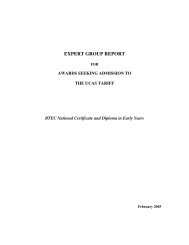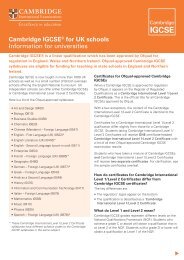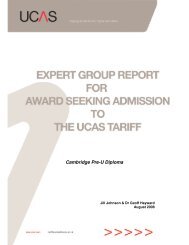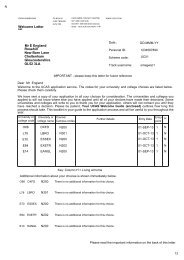International qualifications 2013 (pdf) - CUKAS
International qualifications 2013 (pdf) - CUKAS
International qualifications 2013 (pdf) - CUKAS
You also want an ePaper? Increase the reach of your titles
YUMPU automatically turns print PDFs into web optimized ePapers that Google loves.
Qualifications currently offered<br />
Subject: Maths<br />
Standard Level Extended Level<br />
Stanine Scores Max. 50 points Max. 50 points<br />
1st stanine – lowest 4% 0% – 10% 0% – 10%<br />
2nd stanine – very low 7% 11% – 18% 11% – 28%<br />
3rd stanine – low 12% 19% – 30% 29% – 40%<br />
4th stanine – low medium 17% 31% – 42% 41% – 54%<br />
5th stanine – medium 20% 43% – 54% 55% – 56%<br />
6th stanine – high medium 17% 55% – 66% 67% – 76%<br />
7th stanine – high 12% 67% – 76% 77% – 86%<br />
8th stanine – very high 7% 77% – 86% 87% – 94%<br />
9th stanine – highest 4% 87% – 100% 95% – 100%<br />
Subject: Geography<br />
Standard Level Extended Level<br />
Stanine Scores Max. 50 points Max. 60 points<br />
1st stanine – lowest 4% 0% – 22% 0% – 10%<br />
2nd stanine – very low 7% 23% – 32% 11% – 22%<br />
3rd stanine – low 12% 33% – 44% 23% – 37%<br />
4th stanine – low medium 17% 45% – 56% 38% – 55%<br />
5th stanine – medium 20% 57% – 68% 56% – 72%<br />
6th stanine – high medium 17% 69% – 76% 73% – 83%<br />
7th stanine – high 12% 77% – 82% 84% – 90%<br />
8th stanine – very high 7% 83% – 88% 91% – 95%<br />
9th stanine – highest 4% 89% – 100% 96% – 100%<br />
Subject: Chemistry<br />
Standard Level Extended Level<br />
Stanine Scores Max. 50 points Max. 60 points<br />
1st stanine – lowest 4% 0% – 22% 0% – 10%<br />
2nd stanine – very low 7% 23% – 32% 11% – 22%<br />
3rd stanine – low 12% 33% – 44% 23% – 37%<br />
4th stanine – low medium 17% 45% – 56% 38% – 55%<br />
5th stanine – medium 20% 57% – 68% 56% – 72%<br />
6th stanine – high medium 17% 69% – 76% 73% – 83%<br />
7th stanine – high 12% 77% – 82% 84% – 90%<br />
8th stanine – very high 7% 83% – 88% 91% – 95%<br />
9th stanine – highest 4% 89% – 100% 96% – 100%<br />
Pre-2004 the grading system was as follows:<br />
6 celujacy (excellent)<br />
5 bardzo dobry (very good)<br />
4 dobry (good)<br />
3 dostateczny (satisfactory/pass)<br />
2 mierny (mediocre)<br />
1 niedostateczny (unsatisfactory)<br />
EDUCATION SYSTEM<br />
The education system consists of primary schools, lower<br />
secondary schools and upper secondary schools (general upper<br />
secondary, technical upper secondary, specialised upper<br />
secondary and basic vocational schools). Tuition in state schools is<br />
free. Full-time compulsory education continues until the pupil is<br />
16 years of age. Part-time compulsory education, however, in<br />
school or out-of-school, lasts until 18 years of age (based on the<br />
Constitution of the Republic of Poland adopted in 1997).<br />
Full-time compulsory education in primary schools starts when<br />
the child reaches seven years of age. However, starting 2004/05<br />
school year, all six-year-old children are obliged to attend preschool<br />
classes (either in kindergartens or in primary schools) in<br />
order to complete a mandatory year of preparation for primary<br />
education. Education in primary schools lasts six years. This sixyear<br />
period culminates in national testing, to provide information<br />
on how much pupils have learned. Progression is on to<br />
gimnazjum (lower secondary school). Primary and lower<br />
secondary schools (ie compulsory schools) have so-called “school<br />
areas”, which means that every child who is a resident of that<br />
area is admitted in his/her local school. If parents wish to choose<br />
another school, they are free to do so provided there are places<br />
available.<br />
The three-year period at lower secondary school concludes with<br />
an examination, split into two parts: humanities and science (the<br />
latter combining mathematics and natural science). A foreign<br />
language element has been included since 2009. Upper<br />
secondary schools are selected on the basis of the results of this<br />
examination. Students choose from three-year general upper<br />
secondary schools (liceum), four-year technical upper secondary<br />
schools (technikum), two-three-year basic vocational schools<br />
(zasadnicza szkola zawodowa) or three-year specialised upper<br />
secondary schools (liceum profilowane).<br />
Education at vocational schools concludes with a professional<br />
examination, which, from 2004, is externally assessed.<br />
Specialised upper secondary schools offer a combination of<br />
academic and vocational study, which can act as a base to obtain<br />
professional <strong>qualifications</strong> in post-secondary schools (szkola<br />
policealna). Specialised upper secondary and general and<br />
technical upper secondary schools culminate with the matura.<br />
From 2004/05 a new system of matura examinations was<br />
implemented. Assessment is through externally assessed written<br />
examinations and oral examinations assessed in school (the latter<br />
concern both Polish/mother tongue and modern languages).<br />
Subjects are available at basic and advanced levels.<br />
ACCESS TO HIGHER EDUCATION<br />
On passing the matura school-leaving examination, students<br />
may continue their education at an institution of tertiary<br />
education (university or college). Dependent on the type of<br />
institution, field and duration of study, students read for the<br />
licentiate (minimum three years of study) or engineer (minimum<br />
three and a half years of study), or for a master’s degree (four<br />
and a half to six years, depending on the field of study, socalled<br />
long-cycle programmes). Upon completion of licentiate or<br />
engineer studies (first-cycle programmes), the graduates can<br />
continue their education undertaking second-cycle<br />
programmes leading to master’s degrees (lasting one and a<br />
half to two years). On graduation, holders of the master’s<br />
degree may begin doctoral studies (third-cycle programmes) or<br />
non-degree postgraduate studies. Non-degree postgraduate<br />
studies can usually be pursued by holders of licentiate degrees<br />
as well as those holding master’s degrees.<br />
Portugal<br />
EVALUATION<br />
Diploma de Ensino Secundário (previously known as<br />
Certificado do 12° ano)<br />
The Diploma de Ensino Secundário is granted after successful<br />
completion of the 12th year of schooling. Acceptable as a group<br />
qualification satisfying general entrance requirements for UK<br />
HEIs, provided that an overall grade of at least ‘bom’ has been<br />
achieved.<br />
GRADING SYSTEM - between 0 and 20 - pass mark 10<br />
20 – 18 muito bom (excellent)<br />
17 – 14 bom (good)<br />
13 – 10 suficiente (pass)<br />
9 – 5 mediocre (poor)<br />
4 – 0 mau (very poor)<br />
EDUCATION SYSTEM<br />
Nine years of compulsory basic education is followed by three<br />
years of secondary education, which may comprise courses with<br />
INTERNATIONAL QUALIFICATIONS 49



